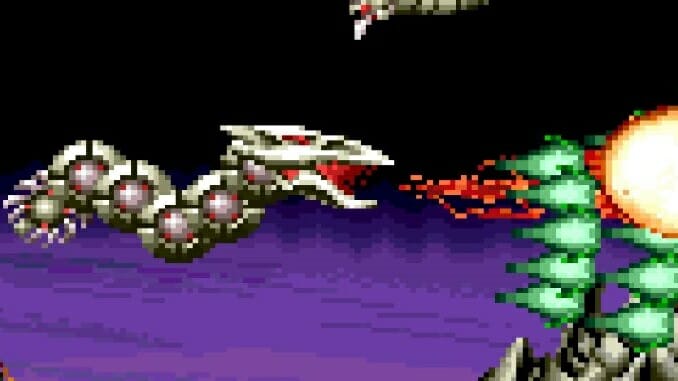Welcome to The Shmuptake, an occasional column about the history of the shoot ‘em up, aka the “shmup.” Here’s an introduction.
If you’ve ever played a shoot ‘em up, you’re probably familiar with pods. They’re a standard feature of the genre. You know when you collect a power-up and instead of getting a new weapon or a burst of speed you get a little capsule that floats alongside your ship? Sometimes it serves as an extra gun, sometimes it’s a defensive barrier, sometimes it’s both. Shmups are absolutely full of ‘em, these pods, and they almost always work in routine, predictable ways. And when they don’t, it’s worth writing about.
Saint Dragon, a 1989 shooter designed by NMK and published by Jaleco, does something genuinely unique with the pod concept. Instead of making you collect them as power-ups, and stripping them away from you every time you die, Saint Dragon just straight-up gives you all the pods you need right from the start. You see, your character isn’t a traditional shoot ‘em up spaceship. It’s some kind of cyborg dragon skeleton that soars through the air, spitting out bullets, flame, and bombs in equal measure. It’s not even a whole dragon, a la Dragon Spirit; it’s like somebody grabbed hold of a dragon’s skull and then ripped it off the body, with only the spinal column dangling beneath it. That skull then had to protect its world from an onslaught of alien invaders, with that string of five disembodied vertebrae dragging behind.
Those are the pods. The vertebrae. Your flying space dragon’s backbone is the key to victory in this one.
These five makeshift pods don’t fire anything. You can’t rearrange them for defensive purposes with the press of a button, as in R-Type. You can rearrange them for defensive purposes simply by moving your ship, though, and effectively positioning those vertebrae to protect your ship is crucial to success in Saint Dragon. They effectively form a tail, and although you can’t move the tail directly, you can coil it around your ship to block shots or use it to inflict damage on any enemies that it happens to touch. That tail isn’t long enough to completely surround your ship—it can basically shield either the top or bottom of your ship, leaving you vulnerable from the other side and from the front. It takes some getting used to, and there’s a pretty wide gulf between knowing how to use your robot dragon spine for defense, and how to use your robot dragon spine for defense well.
At first the defensive properties of your vertebrae seem like a weird but optional quirk-a gimmick intended to make the game stand out amid the glut of arcade shooters, and not an integral game design element. By the third level, though, you’ll realize how thoroughly NMK considered the applications of its dragon spine. Memory and pattern recognition are a huge part of most shmups, and in Saint Dragon you’ll have to remember the optimal position to angle and shift that backbone to survive increasingly complicated enemy patterns.
Beyond the spine, Saint Dragon has relatively simple weapon and power-up systems. You start off with a combo of a single-shot primary weapon and a flame attack that’s a little bit slower but considerably more powerful. Both are fired simultaneously with the press of a single button. As you collect power-ups, you can keep adding additional shots to your main gun until you’re firing a spray of five bullets that spread out across the screen. The flame is one of a handful of secondary weapons, with other options including a disc that shoots out in a straight line, and bombs that shoot out of the top and bottom of your ship at 45 degree angles and bounce across the edges of the screen. There’s not much variety to the weapons, which places even more importance on smartly using the tail of boney cyber pods trailing behind your flying dragon skull.
Saint Dragon would be a fairly generic and forgettable shmup if it wasn’t for that one weird central mechanic. It approaches the already formulaic concept of pods from a unique angle, turning a played out cliche of the genre into something unusual and malleable. You probably don’t need to spend any time on this game if you aren’t deeply invested in shmups and familiar with the major games that defined the genre in the ‘80s. If you do have a working knowledge of the form, though, and have never experienced Saint Dragon’s weird take on pods, get ready to call yourself a dragon chiropractor, because you should be manipulating this cyber dragon’s spine whenever you have the time.
Saint Dragon
Year: 1989
Developer: NMK
Publisher: Jaleco
Original Platform: Arcades
Platform We Played It On: Switch, as part of Hamster’s Arcade Archives
Also Available On: PlayStation 4, as part of Hamster’s Arcade Archives
Senior editor Garrett Martin writes about videogames, comedy, travel, theme parks, wrestling, and anything else that gets in his way. He’s also on Twitter @grmartin.